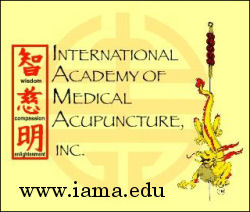Acupuncture & TCM Articles

Acupuncture Articles
by John A. Amaro L.Ac., Dipl.Ac.(NCCAOM), DC
 Dr. Amaro is an internationally known author, lecturer and practitioner beginning his practice of Acupuncture and Chiropractic in 1971. He has led 13 diplomatic Acupuncture study tours of The People's Republic of China escorting more than 500 doctors and practitioners. He has personally studied Acupuncture in nine separate Asian nations. Dr. Amaro is an internationally known author, lecturer and practitioner beginning his practice of Acupuncture and Chiropractic in 1971. He has led 13 diplomatic Acupuncture study tours of The People's Republic of China escorting more than 500 doctors and practitioners. He has personally studied Acupuncture in nine separate Asian nations.
He has received Certification in Acupuncture through the Columbia Institute of Chiropractic in 1973. This was one of the first Acupuncture postgraduate education programs for physicians in North America commencing in 1972.
He has been certified by the Waseda Acupuncture College in Tokyo, Japan in 1974 and graduated from the Chinese Medical Institute, Kowloon, China in 1976. He had previously taken postgraduate studies at the Tai Chung Medical School Taipei, China 1973.
THE DOCTORS NOTEBOOK
Dr. Debra Richel, Dr. John A. Amaro
"THIS ARTICLE COULD SAVE YOUR LIFE"
John A. Amaro L.Ac., Dipl.Ac.(NCCAOM), DC
A recent University of Arizona study concluded of 500 kitchen dishtowels and sponges tested, two-thirds contained bacteria which could cause food poisoning when people used them and then handled food. Many of us are unknowingly poisoning ourselves continually and may never be the wiser until what is read here is understood and acted upon.
It is estimated each year between 40-80 million cases of food poisoning occur in the United States alone. These illnesses include a number of symptoms from stomach cramps, nausea, diarrhea and vomiting to death. No case of food related illness is a minor problem. These illnesses occur from bacteria, mold, yeasts or virus. Food poisoning is very prevalent even in some of America's most notable restaurants and private homes. Remember, what many Americans describe as the 24 hour flu, is in reality a case of food poisoning.
Obeying the following rules is mandatory to insure our safety:
IN THE KITCHEN
1. Wash your hands before meal preparation.
2. Wash your hands after meal preparation.
3. Wash your hands before unpacking groceries.
4. Wash your hands after handling raw meat, seafood, or poultry.
5. Do not go from handling raw meat, seafood, or poultry to another task in the kitchen without first washing hands. This rule is more extensive than rule #3.
6. Wash everything that raw meat, seafood and poultry touches----plates, utensils, cutting boards, counters, etc, this is vital. If you handled the dishtowel after handling raw meat, seafood or poultry before you washed your hands, use a clean towel.
7. Wash all produce before use, even if it is organic.
8. Thaw frozen food from the refrigerator under cold running water, or in the microwave under defrost. Do not thaw frozen food at room temperature.
9. Use a fresh dishtowel each time you cook.
10. Change sponges often and clean the sponge with soap and hot water after any exposure to raw animal product.
11. Marinate meat, poultry and seafood in the refrigerator; Do not use marinade as a sauce or in cooking unless you first bring it to a boil.
12. Refrigerate leftovers within one hour after cooking.
13. Large amounts of leftovers like stews, soups and casseroles should be divided into smaller containers so they cool faster. A large amount of food in a large container may take hours to cool even in the refrigerator. This gives bacteria plenty of time to proliferate.
14. Eat leftovers within 48 hours or freeze them.
15. Store starches such as stuffing, rice, pasta etc. in separate containers from meat, seafood and poultry.
AT THE SUPERMARKET
1. Plan your shopping so perishable items are picked up just before checkout.
2. Do not purchase packages that are damaged, loosely wrapped, leaking or have been resealed, even if they are on sale.
3. Dented cans should be avoided, but if the seal is intact, the contents are presumed safe. If the can is leaky, rusty, the label is stained, the ends bulge or the contents have an abnormal odor, discard it.
4. Plan your errands so the supermarket is the last stop before you go home. When you arrive home refrigerate and freeze perishable items as soon as possible. (In Arizona especially, it is advisable to carry a small ice chest in the car to avoid spoilage while in route from market to home if there will be any significant elapsed time.
5. Frozen meat, poultry and seafood should be free of ice crystals. Fresh fish should smell fresh.
6. Don't select dairy products if the container does not feel cold.
7. Check dates on dairy products. Often containers shelved in the back of a refrigerated shelf can be more fresh by a week or more.
IN THE REFRIGERATOR
1. Throw out any item that has passed the "use by" date on the label.
2. Throw out any item that is two days past a "sell by' date on the label.
3. Throw out any leftovers that have been in the refrigerator longer than 48 hours.
4. Wipe down the refrigerator to prevent build up of small particles of debris which can breed molds and bacteria.
5. Purchase a refrigerator and freezer thermometer. The refrigerator should be between 34-40 degrees. The freezer should be between 0 - 5 degrees.
6. Make sure raw meat, poutlry and seafood are in containers that will prevent their juices from leaking.
7. Keep eggs in the cartons rather than transferring to the egg compartment of the refrigerator. This prevents cross contamination.
Source of Infection: CAMPYLOBACTER
Causes: Undercooked meat, poultry and seafood.
Time to Symptom: 2-5 days
Symptoms: Stomach cramps, diarrhea, fever, blood in the stool.
Source of Infection: BOTULISM
Causes: Improperly canned foods
Time to Symptom: 8-36 hours.
Symptoms: Difficulty breathing, swallowing and vision problems. This is a medical emergency.
Source of Infection: CHOLERA
Causes: Seafood from contaminated waters
Time to Symptom: 1-3 days.
Symptoms: Abdominal pain and diarrhea.
Source of infection: GASTROENTERITIS FROM VIRUS
Causes: Food handling without washing hands or seafood from contaminated water. Food that has been coughed or sneezed on.
Time to Symptom: 12-48 hours.
Symptoms: Nausea, diarrhea and vomiting.
Source of Infection: HEPATITIS A
Causes: Food handling without washing hands or seafood from contaminated water.
Time to Symptom: 15-50 days.
Symptoms: Liver disease, jaundice, low energy, nausea.
Source of Infection: SALMONELLA
Causes: Undercooked meat, poultry or foods that have been contaminated by their juices. Food handlers who have not washed their hands.
Time to Symptoms: 12-48 hours.
Symptoms: Cramps, nausea, fever, vomiting.
Source of Infection: SHIGELLA
Causes: Food handling without washing hands.
Time to Symptoms: 1-7 days.
Symptoms: Cramps, nausea, vomiting, diarrhea, bloody stool, fever.
Source of Infection: STAPHLYCOCCUS
Causes: Food handlers, who do not wash their hands. Food that has been coughed or sneezed on. Staph is present around skin infections such as pimples or boils, thus it can be transmitted if the person touches the pimple then handles food. Washing of the hands is mandatory.
Time to Symptoms: 1-8 hours.
Symptoms: Abdominal cramps, nausea, vomiting, diarrhea.
Source of Infection: CLOSTRIDIUM PERFRINGENS
Causes: Large portions of warm food that cools too slowly in the refrigerator or are left out too long at room temperature.
Time to Symptom: 8-24 hours.
Symptoms: Abdominal pain, diarrhea. May also have nausea and vomiting.
|
